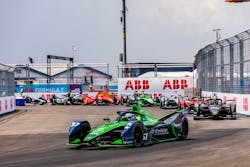Putting the Pedal to the Metal: The High Hopes and Big Learnings on the Formula E racing series in NYC
Those were three driving factors at this past weekend’s New York City E-Prix, part of the worldwide ABB Formula E electric racecar series. The event at the Red Hook road course in Brooklyn offered up two competitions among the world’s best in this form, but also tremendous experience to better hone the craft and share some adrenaline with a surprisingly large and passionate fan base.
Make no mistake, these nearly dozen teams feature some of the world’s best auto developers who are clearly in it to win it. These are competitive men and women.
At the same time, they are doing this for a grander long-term vision, to illustrate the vibrancy and viability of electric vehicles to a wary, uncertain customer base.
“We have a race-to-road program,” noted Paige Debooy, who is a partnership manager with India’s EV developer Mahindra. “All the data we capture from the drivers and the races—we’re establishing how we can bring that to road cars.”
EnergyTech's coverage of Formula E: Vroom to run and advancing the EV Future
See our full coverage of the E-Mobility sector
That brings it back home beyond niche, single-seater vehicles topping well past 120 MPH. What the Formula E series can translate to the everyday driver is state-of-the-art handling, longevity, power density, range relief.
Swiss-based grid technology firm ABB is sponsoring the Formula E series because it believes in and is betting big on e-mobility globally in the future. The company already is way in front on Level 2 and fast charging infrastructure and plans to spend billions more as EVs quite possibly become mainstream.
“Anybody who drives an electric car, you don’t want to go back to the pollution and the noise; no way you go back,” predicted Frank Muehlon, president of ABB’s E-Mobility unit. “It’s just a question of how fast does it get there.”
An early innovator like Tesla has been banking on this for a long time. The automakers who supply everyday drivers, those legacy giants such as GM, Ford, Toyota and Nissan, are promising fleet conversions from internal combustion machines to battery-electric models in the near future.
Some other big-time auto names such as Nissan, Porsche, Andretti Motorsports and Mahindra are invested, too. They’re seeing the future beyond the next turn, even if it’s a short-term struggle to charge that gap.
“This year has been disappointing, but we’re building for next year,” Debooy said. “Next year, we’re looking to use a new generation power train which will be 100 kilograms lighter and 100 KW more powerful.
“The power train is really essential,” she added.
Indeed, Formula E is quite, hmm, "formulaic" in some ways as teams use the same McLaren Applied Technologies battery systems and nearly identical Spark Gen-2 chassis, carbon-fiber bodies and Michelin tires. The difference is how they innovate and adapt on the powertrain-motor side of the equation.
This is the eighth season of Formula E, conceived more than a decade ago and kicked off with a 2014 race in Beijing. This year’s circuit holds two races in every participating city, with the NYC E-Prix being followed by London and then the finale in Seoul.
The New York race, the first to allow a public audience in three years due to COVID-19, was an outright buzz from the weekend’s beginning. The grounds were full of activities and the grandstands full of fans.
The first race was a bit of a stunner, with the Envision team’s Nick Cassidy leading most of the way before a short, heavy rain caused significant puddling that hydroplaned the frontrunners. Those soggy turns sent them crashing into the wall or each other, effectively ending the race with Cassidy in front and Lucas da Grassi of ROKIT Venturi Racing as the runnerup. On Sunday, Antonio Felix da Costa of DS TECHEETAH won the day in pole position start to finish victory.
This was Cassidy’s first ever Formula E win and all he could do was shrug and express gratitude for the cup.
“It’s not quite the way we would like it, but we’ll take it,” he said. “There’s a lot to manage in the races.”
For sure, as Formula E has several quirks unknown in the internal combustion racing world. They can run fast within certain limits, but a key is to have enough kilowatt power to finish. For instance, drivers can win “fan boosts” that actually allow them to increase their KWh juice.
Whether that is fair or not fair is certainly an argument, but EV racing is working hard to cultivate a passionate fan base. And this first-time observer clearly saw the mass appeal right before his eyes. Formula E is a hot ticket with a buzzing grandstand crowd roaring whenever a pass was made in the straightaway of the winding, right-and-left turns of the Red Hook course which is close to the Brooklyn Cruise Terminal and offers a breathtaking view of the Manhattan skyline.
ABB is all-in, investing some $14 billion toward electrification manufacturing, research and development and logistics sectors. The company has added 120 new workers just to focus on growth in the charging infrastructure sector in the U.S.
“We look forward to a very dynamic future for electrification in the U.S.,” said Michael Plaster, executive vice president and lead business manager for ABB’s U.S. Electrification efforts here.
-- -- --
(Rod Walton, senior editor for EnergyTech, is a 14-year veteran of covering the energy industry both as a newspaper and trade journalist. He can be reached at [email protected]).
About the Author
Rod Walton, EnergyTech Managing Editor
Managing Editor
For EnergyTech editorial inquiries, please contact Managing Editor Rod Walton at [email protected].
Rod Walton has spent 17 years covering the energy industry as a newspaper and trade journalist. He formerly was energy writer and business editor at the Tulsa World. Later, he spent six years covering the electricity power sector for Pennwell and Clarion Events. He joined Endeavor and EnergyTech in November 2021.
Walton earned his Bachelors degree in journalism from the University of Oklahoma. His career stops include the Moore American, Bartlesville Examiner-Enterprise, Wagoner Tribune and Tulsa World.
EnergyTech is focused on the mission critical and large-scale energy users and their sustainability and resiliency goals. These include the commercial and industrial sectors, as well as the military, universities, data centers and microgrids. The C&I sectors together account for close to 30 percent of greenhouse gas emissions in the U.S.
He was named Managing Editor for Microgrid Knowledge and EnergyTech starting July 1, 2023
Many large-scale energy users such as Fortune 500 companies, and mission-critical users such as military bases, universities, healthcare facilities, public safety and data centers, shifting their energy priorities to reach net-zero carbon goals within the coming decades. These include plans for renewable energy power purchase agreements, but also on-site resiliency projects such as microgrids, combined heat and power, rooftop solar, energy storage, digitalization and building efficiency upgrades.




